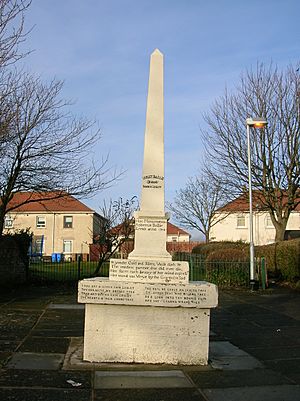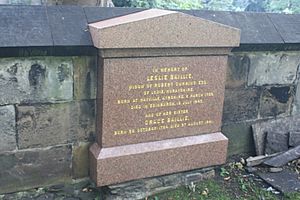Lesley Baillie facts for kids
Quick facts for kids
Lesley Baillie
|
|
|---|---|

Lesley Baillie's memorial
|
|
| Born | 6 March 1768 Mayfield House, Stevenston, Ayrshire, Scotland
|
| Died | 19 July 1843 Edinburgh, Scotland
|
Lesley Baillie (1768–1843) was a Scottish woman famous for being the inspiration behind one of Robert Burns's most beloved poems. She was born in 1768 at Mayville, a house in Stevenston, Ayrshire, Scotland. Her parents were Robert Baillie and May Reid. Later, Lesley married Robert Cumming of Logie, Moray, and became known as Mrs. Lesley Cumming. Robert Burns called her "Bonnie Lesley" and described her as "the most beautiful, elegant woman in the world."
Contents
Lesley Baillie's Life
Lesley Baillie was the daughter of Robert Baillie, who was a sea captain. In 1799, she married Robert Cumming of Logie, a place in Moray. Lesley and Robert had six children together. Sadly, four of their sons passed away while serving in the army in India. Lesley's husband also passed away many years before her.
People remembered Lesley for her kind heart and friendly personality. She was known for being very helpful and having good manners.
Mayville House
Lesley was born at Mayville House in Stevenston. This house was built around 1720 for her father, Robert Baillie. He named it Mayville after Lesley's mother, May Reid. It was a lovely, attractive house. Later, it became part of the Kerelaw Estate.
Later Life and Burial
In her later years, Lesley lived in Edinburgh at 6 Hope Street. She passed away on July 19, 1843. She is buried in the graveyard of St John's Church on Princes Street in Edinburgh. Her sister, Grace Baillie, is buried with her.
The Lesley Baillie Memorial
This special memorial was first put up in 1784 by Robert Baillie to remember his wife, May Reid, and his other daughter, Grace. It is now located in Stevenston, near where Mayfield House used to be.
Lesley's name was added to the memorial much later, in 1929. This happened when the memorial was put back up by members of the Burns Federation. It had been left uncared for over 50 years. Today, North Ayrshire Council takes care of the memorial.
Part of the writing on the memorial for Maria Baillie says:
In yonder Cold and Silent Vault doth lie
The modest partner that did ever die,
Her form each beauty of her mind expressd
Her mind was virtue by the Graces dressd
Robert Burns and Lesley Baillie
Lesley Baillie is most famous because of her connection to the famous Scottish poet, Robert Burns. Burns met Lesley and her sister Grace in August 1792. They were traveling through Dumfries on their way to England and visited him. Even though he was busy, Burns spent the whole day with them.
After they left, Burns was so inspired that he wrote a poem about Lesley. He said he was "in love, souse! Over head and ears." He based his new poem on an old song.
Burns's poem about Lesley begins:
The bonie Lesley Bailie,
O she's gaen o'er the Border;
She's gaen, like Alexander,
To spread her conquests farther...
To see her is to love her,
And love but her for ever;
For nature made her what she is,
And never made anither!
Burns was very proud of this song. He called it "one of the finest songs I ever made in my life." He never saw Lesley Baillie again after that day. However, he wrote to her in May 1793 and sent her another song he had written for her, called "Blythe hae I been on yon hill."
Lesley's daughter, who was also named Lesley, shared a story about Burns. She said that Burns was working on a poem and was having trouble with a line. Lesley suggested a change, and it helped him finish the poem perfectly.
Burns once wrote that when he sang about women like Lesley Baillie, he only had to pretend to be in love because their beauty was real. This shows how much he admired her.
See also
- Jean Armour
- Alison Begbie
- Mary Campbell (Highland Mary)
- Nelly Kilpatrick
- Jessie Lewars
- Mary Morison
- Ann Park
- Anne Rankine
- Isabella Steven
- Peggy Thompson






